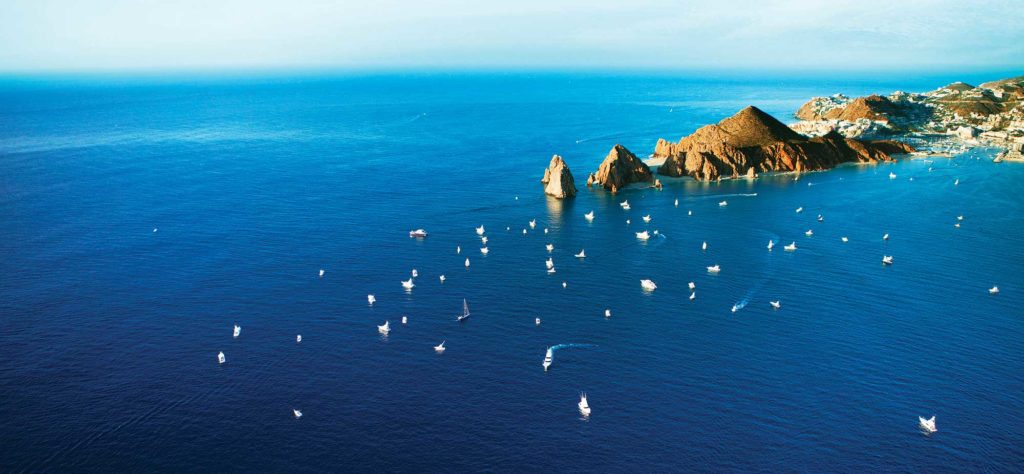
Cabo. The name conjures images of leaping marlin, rambunctious dorado, high fives after a day of fishing, celebrating with a cold Pacifico, and reliving the day over margaritas at the swim-up bar. This, however, is a tale of two Cabos.
There’s Cabo San Lucas fishing. Then there’s East Cape fishing. Both easily accessible from Los Cabos International Airport, each offers a shot at heart-pounding fishing action in the waters surrounding the tip of Mexico’s fabled Baja California peninsula.
Yet, those are about the only similarities between the two Cabo fishing destinations. They are separated by roughly 100 miles of desert coastline, rugged headlands and sweeping white-sand beaches, as well as a profound difference in tourism philosophies. One focuses on heavy commercialization, while the other holds back on rampant growth with an eye toward preserving the unique experience of fishing in Old Mexico.

There are indeed sport-fishing-oriented resorts between the two Cabos — including the Marina Puerto Los Cabo near San Jose del Cabo and the Costa Palmas Marina near the town of La Ribera — but the great majority of visiting anglers choose to stay at either Cabo San Lucas or East Cape.
As a first-time visitor, how do you decide which destination is right for you?
The most important question to ask yourself is, “What kind of experience am I looking for: great fishing spiced by the nightlife of a party town, or great fishing blended with tranquil evenings overlooking the Sea of Cortez?”
Answer this question, then decide to venture southward from the airport to the bustling tourist town of Cabo San Lucas, or trek northward to the remote resorts of East Cape. Here’s what you will find at each.
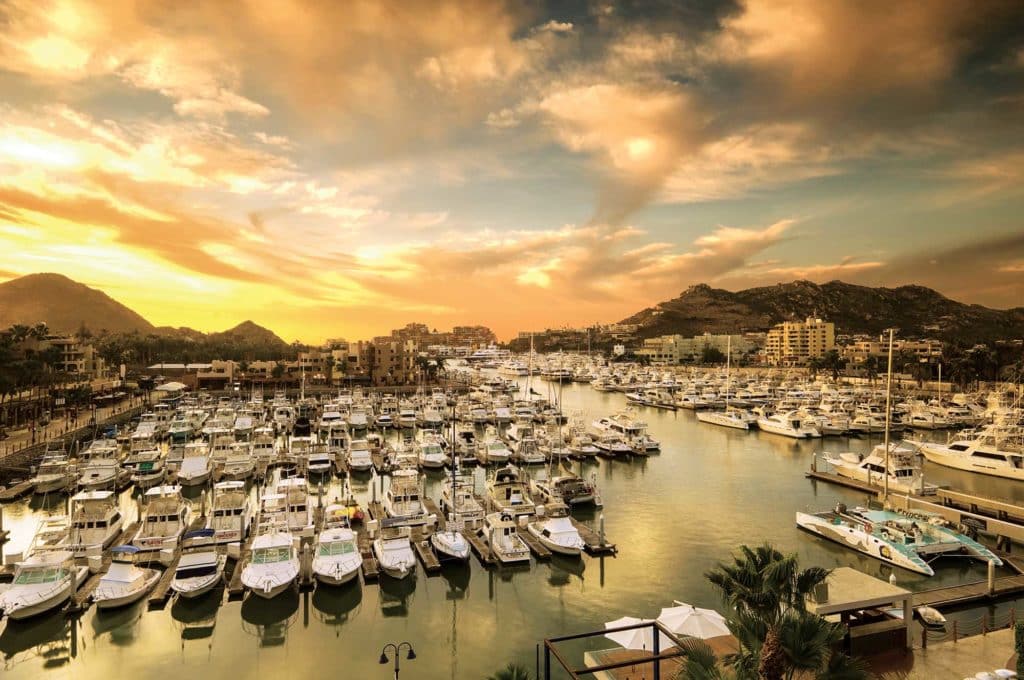
Cabo San Lucas Fishing
On a recent sojourn to Cabo San Lucas, I awoke early each morning and took a stroll in the pre-dawn darkness. From the heights of Paseo de la Marina, I could gaze inland across a vast expanse of city lights and felt a sense of amazement, tempered by nostalgia.
The once-sleepy fishing town has passed into angling history, having morphed into a sprawling metropolis with a population conservatively estimated at nearly 92,000.
My destination during the morning walks was the centerpiece of this town, Marina Cabo San Lucas. With 380 slips, 24-hour security, a launch ramp, fuel docks, ships store, shore power and its own desalination plant, this marina is state of the art. Managed by Island Global Yachting, it is one of the largest marinas in Baja and rivals any recreational port in the United States.
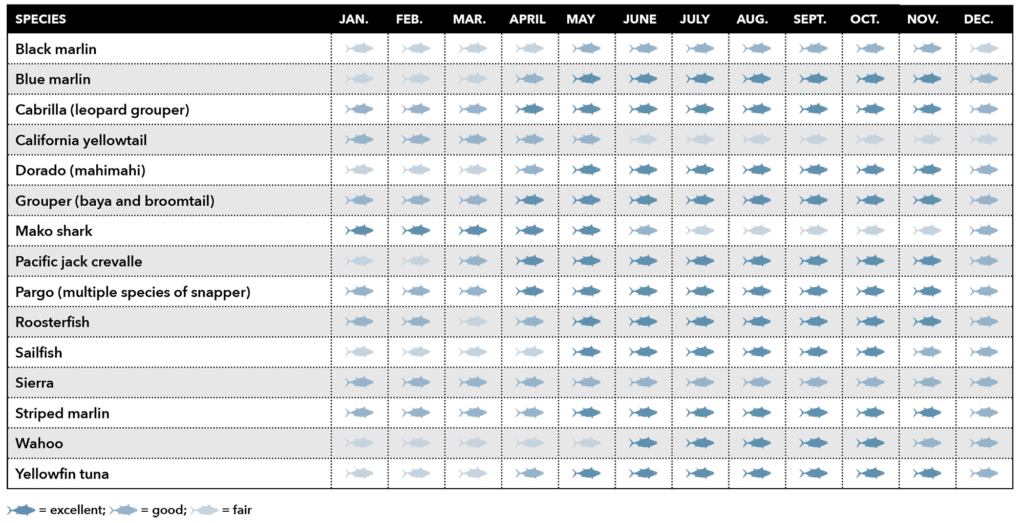
For anglers, mornings start early for Cabo fishing trips. It was still dark by the time I arrived, but the docks brimmed with activity as crewmembers loaded charter boats with fishing gear, ice and provisions. Food carts along the malecon (the esplanade surrounding the marina) prepared and sold hot breakfast burritos and lunches for departing anglers and crewmembers on Cabo San Lucas fishing charters.
Yet the docks empty quickly around dawn as the fleet pulls out and funnels through the main channel. Many of the best Cabo fishing charters stop outside the harbor to purchase live bait. A number of local bait fishermen in their pangas are usually standing by, having fished all night to load their wells with Pacific mackerel and caballitos (bigeye scad).
In recent years, a large bait boat, Francesca, operated by Jorge Tellez, owner of the Gaviotas and Solmar charter-boat fleets, has also been stationed outside the harbor to supply live bait.
Once baited up, the boats cruise past the famous rock formations at Finnisterra (Land’s End), including El Arco, the massive stone arch that ranks as the most identifiable landmark of Cabo San Lucas, in pursuit of glory fish, including three species of marlin — black, blue and striped — as well as dorado, wahoo, tuna, sailfish and even swordfish.
When you’re tired of bluewater fishing, target cabrilla (leopard grouper), sierra mackerel (similar to Spanish mackerel, but larger), and pargo (species of snapper). The most prized species when inshore fishing in Cabo San Lucas is roosterfish.
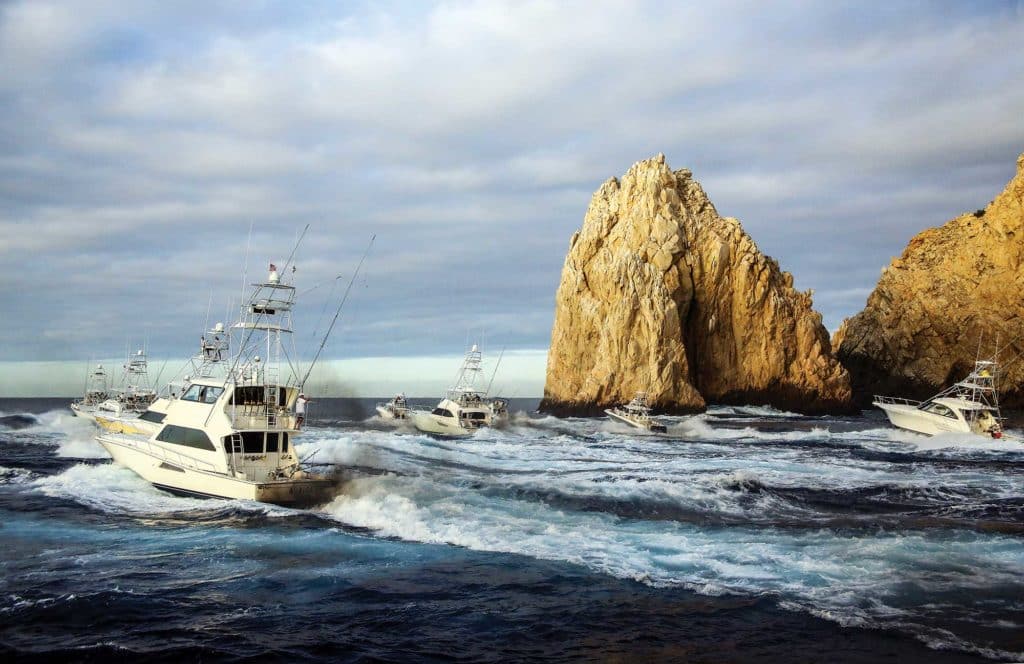
Cabo San Lucas Fishing Charters
While some visiting anglers trailer their own boats here or cruise down from San Diego (1,000-mile passage), it’s far easier and more common to fly down and fish aboard Cabo San Lucas fishing charters, as I did on a trip with Barrett Howarth, vice president for Mag Bay Yachts. We fished aboard a Mag Bay 33, one of 15 boats in the famous Picante Sportfishing fleet.
Located in the northwest corner of the marina, Picante offers a wide choice of charter craft, ranging from a 24-foot Shamrock to a 45-foot Cabo Express. Picante also has two custom yachts up to 68 feet available for larger parties or extended fishing trips.
Our trip aboard the Mag Bay 33 in early December turned out to be a magnificent day during which we caught yellowfin tuna and a striped marlin around the San Jaime Bank on the Pacific side off Cabo, then headed close to shore to catch dorado within casting distance of the beach. Such days are common in Cabo, says Phil Gentile, owner of Picante Sportfishing. “That’s what keeps people coming back to Cabo San Lucas,” he says with a wry smile. Indeed, it was a successful fishing trip that got Gentile started in the charter business.
A virtual unknown in big-game tournament fishing at the time, Gentile entered and won Cabo’s high-stakes Bisbee’s Black and Blue tournament in 1994, catching a 993-pound blue marlin aboard his 40-foot Tollycraft, Picante. He also won a Cabo Yachts 35 convertible, and with that boat started Picante Sportfishing.
One of the largest sport-fishing charter operations is represented by Tellez’s combined Gaviotas and Solmar fleets, located along the eastern side of the marina. These world-renowned charter operations bring together 25 sport-fishing boats, ranging from 22-foot pangas to a 43-foot Bertram.
I have firsthand experience fishing aboard the latter, Don Luis, during a Cabo fishing trip in May. Over the course of two days, Capt. Christian Lopez put us on no fewer than 10 striped marlin around the 1150 Bank, about 23 miles from port.
“Fishing is still the principal activity in Cabo San Lucas, and always will be,” says Tellez, alluding to the diverse activities that draw a million tourists to this area each year. “Marlin support this town. That’s why I let every one of my captains know that they are not to kill marlin.”
Research and advance booking with a reputable charter operator are critical to an enjoyable fishing trip, says Ryan Donovan, owner of RedRum Sportfishing, which operates 12 charter boats ranging from 28 to 78 feet in length.
“None of the reputable fleets use hawkers, guys along the malecon trying sell you on a sport-fishing charter,” says Donovan. “Nine out of 10 times, these are tied to a time-share promotion.
“With a salesman every 15 feet, we call it ‘walking the gantlet,” he adds. “Many times, these charters want to save money, so they won’t burn the fuel necessary to get you to the fish.”
Book at least two days of fishing, but three is even better, Donovan believes. “That way you can experience a variety of species,” he explains. “Maybe fish marlin one day, tuna the next, and then target roosterfish on the third day.”
For a comprehensive list of Cabo San Lucas charter-fishing operators and rates, visit loscabostournaments.com and click on “charters” as well as the Los Cabos Billfish Tournament (October) and the Charter Boat Classic Tournament (November).
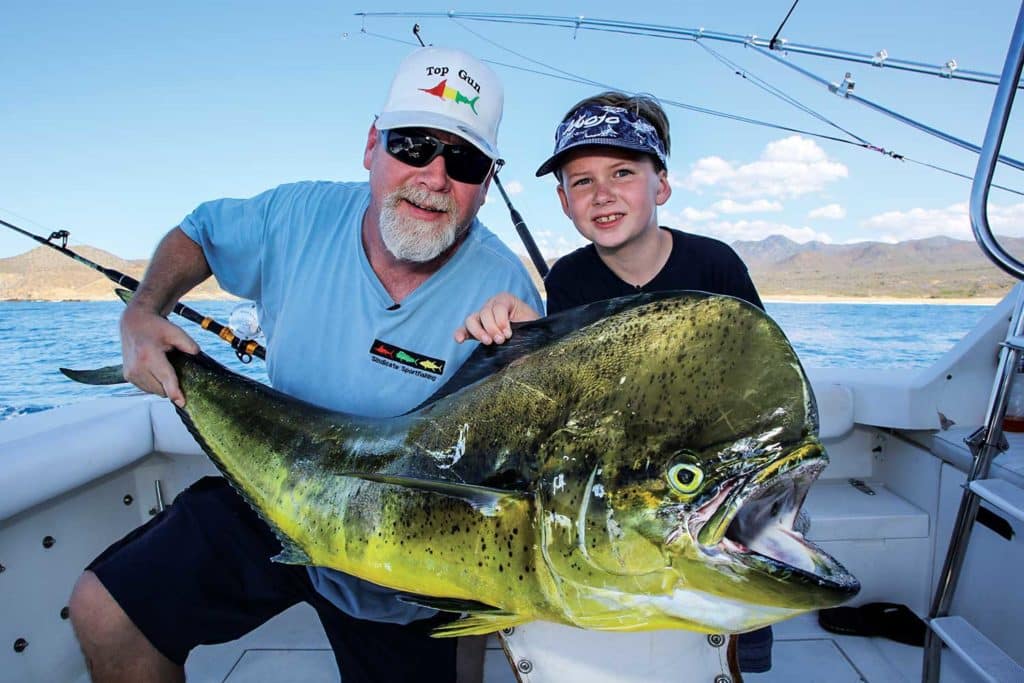
Cabo San Lucas Resorts
A host of fine resorts populate Cabo San Lucas, but among the most convenient for anglers are those that immediately surround the marina, such as the Marina Fiesta Resort and Spa, where I stayed on a recent visit. With some rooms overlooking the marina, the hotel is literally steps from the docks, making it easy to carry gear to the boat. Between fishing trips, you can relax by the pool and enjoy a beverage at the tiki bar.
If you’d rather stay a bit farther from the marina, try a resort such as the Bahia Hotel and Beach Club. Secluded amid quaint avenidas a few blocks above Cabo’s Medano Beach, the Bahia was built a quarter-century ago as a hotel catering to sport fishermen. It’s an easy walk during cool morning hours but a tougher uphill trudge in the heat of the afternoon.
The Bahia features open-air hallways, a central swimming pool and one of the finest restaurants in all of Baja California: Bar Esquina. The management offers parking for trailer boats in the lot adjacent to the resort, with 24-hour security.
Some charter operations also offer their own accommodations, says Donovan. “For instance, we offer packages that include condos and villas for visiting anglers.”
“Our stay-and-play packages are intended for groups and families looking for an alternative to hotels and resorts.” RedRum offers three-, four- and six-bedroom condos. For more hotels and rates, check out Los Cabos Visitors Guide online or visit loscabostournaments.com/los-cabos-resorts.
Cabo San Lucas Dining and Shopping
If you like shopping malls, you’ll love Cabo San Lucas. In fact, there are mall-like retail stores and American-style restaurants lining the marina, including Ruth’s Chris Steakhouse and Swarovski Jewelers in the Luxury Avenue Los Cabos boutique mall. For a more authentic Mexican dining experience, check out places such as Solomon’s Landing restaurant in the far western corner of the marina or Giggling Marlin off Paseo de la Marina, just west of the marina. You can check out more dining opportunities and meal prices by visiting Los Cabo Visitors Guide online.
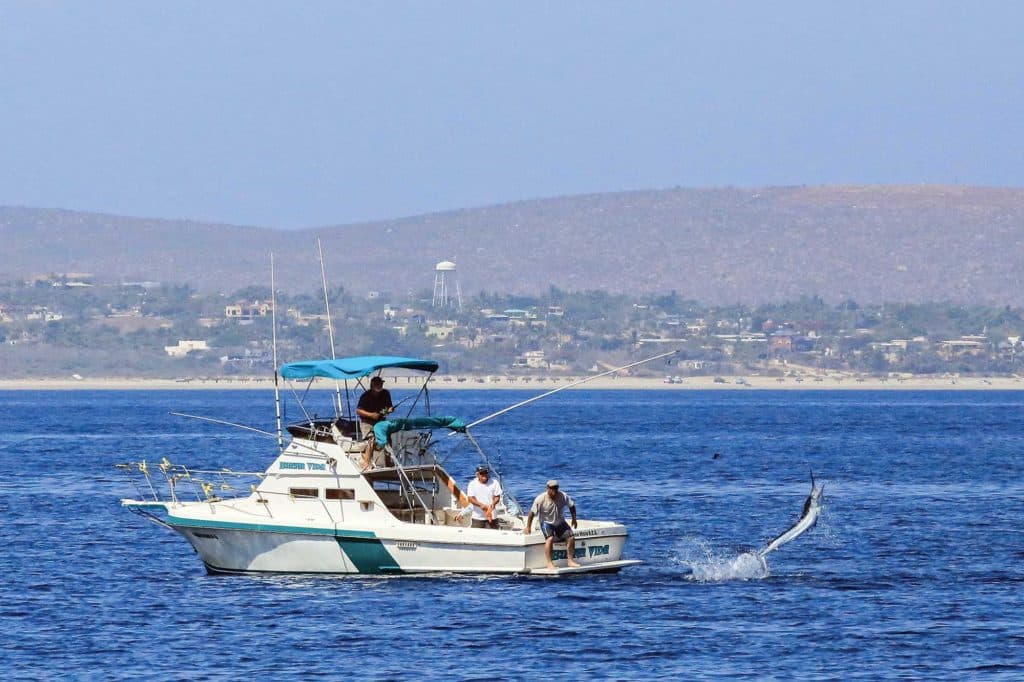
East Cape Fishing
About 45 miles northward from the airport, along Baja’s main transportation artery — Mexico 1 — through the cactus-studded Sonoran desert, are the resorts of East Cape, including Buena Vista Beach Resort, Hotel Palmas de Cortez, Hotel Playa del Sol, Rancho Leonero and others.
Shadowed by the craggy, towering peaks of the Sierra la Trinidad mountain range to the west, each resort is perched on a beach with a view of the Sea of Cortez
Virtually all of the East Cape resorts offer packages with accommodations, meals and fishing. Though there are opportunities to dine in the nearby town of Los Barriles, visiting anglers choose to spend most of their time at the resorts when they’re not fishing.
“East Cape is far more remote and quiet than Cabo San Lucas, and if you’re looking for nightclubs, you won’t find them here,” says Gary Graham, who has been driving down to Baja destinations from the United States since 1973 and pens the Baja Beat column for Western Outdoor News.
Graham is also a representative-at-large for the International Game Fish Association. “I’ve spent more time in East Cape than anywhere else,” he reveals.
East Cape resorts differ in style and amenities, says Graham. “Rancho Leonero, for example, offers more of a fish-camp experience, has great access to the beach, and has assembled one of the biggest panga fleets in the area,” Graham reports.
On the other hand, Hotel Palmas de Cortez — part of the Van Wormer Resorts — is more sophisticated, Graham reports. “Hotel Playa del Sol, also a Van Wormer property, is next door and more like a motel design and less expensive than Palmas,” he says. As an alternative, Hotel Buena Vista Beach Resort offers “a more Mediterranean experience,” Graham adds.
To learn more about East Cape resorts, packages and rates, visit eastcaperesorts.com.

East Cape Charter Fishing Fleets
Virtually all East Cape resorts field their own fleet of sport-fishing boats, and most offer a range of vessel sizes. At the Van Wormer resorts, for example, you can charter three grades of diesel-powered flybridge cruisers — standard, deluxe and super-deluxe — as well as superpangas. Cruisers offer a greater level of comfort and passenger room than the superpangas, so most guests opt for the former.
Just as in Cabo San Lucas, every day starts early as visiting anglers — box lunches and gear in hand — hit the sand before sunup, waiting to board their boats for a day of fishing.
At some resorts, piers extend from the beach, allowing boats to dock momentarily while guests step aboard. At other East Cape resorts, pangas shuttle anglers from the beach out to the larger boats. Relatively calm waves along the shores of the Sea of Cortez make boardings easy.
Other pangas hover outside the main fleet, their wells stocked with Pacific mackerel and/or caballitos, awaiting an opportunity to sell live bait to the boats heading out. Live bait is particularly important when targeting dorado, roosterfish and striped marlin.
Some days, the best offshore fishing takes boats out anywhere from 15 to 25 miles, but the deep-sea ledges and canyons that run close to the coast can spell good action for dorado, marlin, sailfish and wahoo closer to home at times.
East Cape is also a prime area for roosterfish, particularly the crystal-clear shallow waters off nearby Punta Arena. Slow-trolling live baits can produce roosters weighing 50 to 65 pounds.
It’s hard to cover in one story all the fishing opportunities you’ll find in this region of Mexico. Suffice it to say, you could spend a lifetime fishing here and not experience it all. For example, we haven’t even delved into the fishing opportunities for species such as cabrilla, California yellowtail, pargo, sierra mackerel or thresher sharks.
If you haven’t fished here, put it on your bucket list. In fact, list it twice — once for Cabo San Lucas and again for East Cape. Then you can tell your own tale of two Cabos.
Traveling to Cabo
Los Cabos International Airport is served by a host of air carriers, including American, Alaska, Delta, Southwest and United, with service from major U.S. cities such as Atlanta, Baltimore, Charlotte, Dallas, Denver, Houston, New York JFK, Los Angeles, Portland, Seattle, St. Louis and Washington D.C. Check with your travel agent, travel website or airline website to find the best fares, dates and times.
When you book your accommodations, ask about transfers from the airport to the hotel. Some hotels and resorts bundle the shuttle service to and from the airport into your booking package. From the airport to Cabo San Lucas is about 40 minutes. It takes about an hour to reach East Cape resorts from the airport.
Cabo San Lucas Fishing Tackle
Back in the day, the quality and selection of tackle provided by sport-fishing charter boats was — in a word — inconsistent. That forced many visiting anglers into the hassle of taking a selection of their own tackle as luggage.
That’s no longer the case, at least in Cabo San Lucas and East Cape. Charter operators at those hot spots provide top-notch rods and reels spooled with fresh line. And they provide the lures, leader line and terminal tackle for any opportunity that might arise.
If you really want to bring an outfit or two, for marlin trolling, think about Shimano Tiagra 30W trolling reels spooled with 50-pound-test monofilament and matched to custom 6-foot trolling rods equipped with AFTCO roller guides.
For casting live baits to marlin, a Shimano Torium 30 spooled with 40-pound monofilament with a wind-on 80-pound-test leader and a 7-foot medium-heavy action rod with conventional ring guides would be a good choice. You can also use this for dorado or roosterfish.








